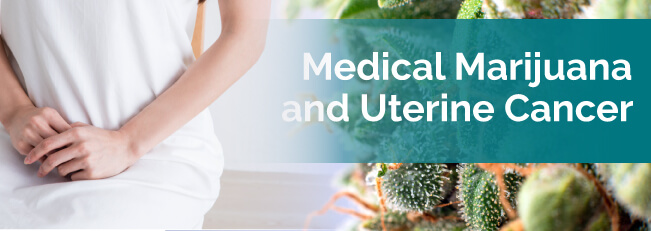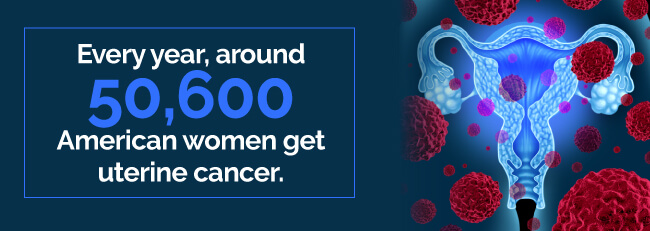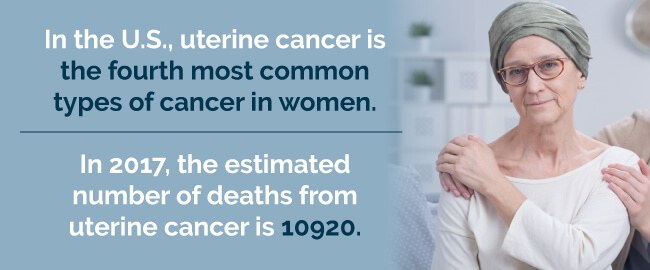
Nearly every individual in the United States has seen, at least in some form, what cancer can do, whether they’ve experienced themselves or in someone they love. And, even though marijuana is not approved by the U.S. Food & Drug Administration (FDA) at the federal level just yet for treating cancer, the shifting landscape surrounding it in America is encouraging.
The transformation of medical use of marijuana for certain conditions is prompting many patients to talk with their doctors about its potential therapeutic effects for cancer-related symptoms and even cancer itself. Medical marijuana for uterine cancer is another area of study going on to this day that’s looking hopeful.
Uterine cancer presents when you have malignant growth in the cells of your body that comprise uterine tissue. The cancer cell buildup may form a malignant tumor (mass). When you have a mass of non-cancer cells, it’s called a benign tumor. Every woman is at risk for uterine cancer — and as she ages that risk increases. Most women who get this cancer have already gone through menopause.
There are a few types of uterine cancer. However, endometrial cancer is the most common since it forms in your uterus lining called the endometrium. Uterine cancer develops gradually. Uterine cancer can start with endometrial hyperplasia, which is less of a serious problem and is an overgrowth of celling in your uterus lining.
The good news, however, is that many uterine cancers are easy to spot early on since they present warning signs like postmenopausal or abnormal bleeding. When found in its early stages, this cancer is often successfully treated.
As mentioned, this type of uterine cancers starts in cell layers that form your uterus lining. Although other types of cancers form in your uterus, such as uterine sarcoma, they aren’t as common as endometrial cancer.
Doctors tend to detect this cancer early since it produces vaginal bleeding out of the ordinary prompting women to consult their doctors. When discovered early, the doctor may cure endometrial cancer by surgically removing your uterus.
There are two primary types of endometrial cancer. These are:
Every year, around 50,600 American women get uterine cancer. Behind breast cancer, lung cancer and bowel cancer, uterine cancer is the fourth most common women’s cancer that killed almost 2,000 women in the year 2011.

In the U.S., the most common type of pelvic gynecologic malignancy is cancer of the uterine corpus. It’s also common in developed countries that have sufficient health care. Carcinomas of the endometrium make up around 95 percent of these malignancies.
For asymptomatic women, experts don’t recommend screening uterine cancer currently. The five-year survival rate for cancer of the uterus that has spread regionally is 69 percent.
Although most women receive a diagnosis of an early stage disease, when diagnosed with advanced disease, they end up with a grim prognosis. Because of this, novel therapies for endometrial cancer treatment are currently under investigation, including getting educated on the genetic basis of how endometrial cancer develops, new molecular targets for treating the disease and novel surgical therapies.
Uterine cancer brings about a variety of both physical and mental effects.
Some physical effects that you may experience with uterine cancer include:
Chances are, you know what’s normal for you, so pay attention to how your body is acting. If you’re experiencing abnormal vaginal bleeding, visit your doctor immediately. If you’re experiencing other signs that last for a couple of weeks or longer, also contact your physician. Something other than cancer may be producing these symptoms, but you won’t know unless you get an evaluation from your doctor and the sooner you do, the better your outcome.

Uterine cancer can bring on social and emotional effects along with physical effects. These social and emotional effects can cause you to deal with difficult emotions like:
You may find it difficult to express your feelings to your family and friends. Others might not know what to say to you in response.
When struggling with uterine cancer, you’re encouraged to share your feelings with your healthcare team. They can help you and your loved ones find coping strategies for social and emotional effects.
According to Cancer.Net, some statistics relating to cancer of the uterus are:

Endometrial cancer facts for 2016 show:
After diagnosing you with endometrial cancer, your doctor and cancer care team will discuss your options for treatment. You’ll have to take time to consider these options carefully before deciding. It’s important that you weigh the benefits against side effects and risks of each treatment option.
Standard treatment options for this type of cancer include:
Most women with endometrial cancer undergo surgery as their primary treatment, however, in some cases, the doctor may combine treatments. The type of treatment you receive depends on your type of uterine cancer and the stage it’s in when diagnosed. Your doctor may consider other factors as well, such as your overall health, age, personal considerations and if you want children when determining the best course of treatment for your case.
Let’s explore your treatment options:
Surgery is usually the primary treatment for uterine cancer and consists of a hysterectomy with or without a salpingo-oophorectomy and lymph node removal. Sometimes it involves pelvic washings, omentum removal and peritoneal biopsies. The surgeon may remove as much of cancer as possible through a debulking procedure if your cancer has spread to your abdomen or pelvis.
Side effects of surgery may include:
With radiation therapy, the doctor uses x-rays or other high-energy radiation to kill your cancer cells. There are a couple of ways they use this to treat uterine cancer:
Sometimes the doctor uses both of these therapies. If your oncologist decides both are needed, the doctor typically performs the external beam radiation first and then the brachytherapy. The grade and stage of your cancer help the doctor determine the areas that require radiation therapy and the types of methods they’ll use.
If your doctor decides you need radiation after surgery, you’ll wait around four to six weeks to heal from the surgery before they start radiation.
Side effects of radiation therapy may include:
Because radiation therapy is a local treatment, it only affects the area of your body where you have the tumor. For instance, if you receive radiation therapy at an area of your body where you have hair growing, like your scalp, you may experience hair loss.
Hormone therapy involves using hormones or drugs that block hormones to fight your cancer. It’s not the type of hormone therapy doctors use to treat menopause symptoms (menopausal hormone therapy or hormone replacement therapy (HRT).
Different hormone treatments for treating uterine cancer may include:
Side effects of hormone therapy may include:
In chemotherapy, the doctor administers cancer-fighting drugs directly through your vein or orally. These medications infuse through your bloodstream reaching all areas of your body, making it a potentially useful treatment if your cancer spread past your endometrium. You may receive combination chemo where you’ll receive more than one drug. Some patients experience a more favorable outcome than one drug alone in treating cancer.
You receive chemo in cycles where you’ll receive treatment and then take a rest period, followed by another treatment and so forth.
Chemo drugs for tackling your endometrial cancer may include:
Often the doctor combines two or more of these drugs for treatment.
Side effects of chemotherapy may include:
It’s essential you talk with your doctor about all your options of treatment, including their side effects and their goals to help come up with the right treatment that fits your needs the best. Be sure you ask questions if you’re unsure of anything.
The cannabis sativa plant has been used both medicinally and recreationally for several hundreds of years. Chinese medicine turned to the cannabis plant for hallucination and pain-relief centuries ago. The plant contains three bioactive molecule classes; terpenoids, flavonoids and cannabinoids (over 60 types). The active compounds in the cannabis plant are cannabinoids.

Recent studies show promise in medical marijuana as an anti-cancer agent, particularly the cannabinoids. They regulate your key cell signaling pathways involving cell survival, angiogenesis, invasion, metastasis and more. The CB1 and CB2 cannabinoid receptors are the primary focus
A huge discovery in using cannabinoids for treating cancer is their potential ability to kill tumors. According to preclinical studies, the THC, synthetic cannabinoid agonists, naturally occurring cannabinoids and endocannabinoids all produce anti-cancer effects in vitro that fight against uterine carcinoma, making medical cannabis for uterine cancer effective.
Like many other parts of the body, the uterus can directly interact with the components in cannabis to relieve cancer symptoms. The uterus contains two types of cannabinoid receptors built to react to cannabinoids: CB1 and CB2. Researchers have found that the uterus has the CB1 receptor, which uses cannabinoids to affect your central nervous system.
We mainly associate the CB1 receptor with the psychoactive effects we get from cannabis. So, when cannabinoids activate the receptors in the uterus, they can impact your brain. But, they also affect the rest of the nervous system, potentially reducing pain, mood problems and other symptoms. Patients dealing with nerve pain and other cancer symptoms could take advantage of cannabis’ palliative relief.
Researchers dove deeper to see how these receptors could impact uterine cancer. They investigated marijuana’s antitumor abilities for cancers like uterine cancer. Using in vitro methods, or studying cells in isolation, they found many kinds of cannabinoids that could help. Cannabinoids that come from cannabis, synthesis and the human body could all inhibit the growth of and kill off cancer cells. When they used in vivo methods, or studied living tissue in an organism, they found similar results.
When you undergo any of the above therapies, you’ll likely experience some adverse side effects that cannabis and uterine cancer treatment may help such as:
Clinical evidence and studies show that medical weed has potential anti-cancer properties that may prevent malignant cells from spreading and inhibit tumor growth and eventually kill it. Not to mention, medical marijuana also helps to counteract the common side effects of chemotherapy and radiation therapy.
Patients who used medical cannabis during their cancer treatment reported it helped ease their constant emotional and physical pain, increased their appetite, warded off their nausea and put them in a better mood. It’s relaxing and sedative and officially approved today as an analgesic, antispasmodic and appetite stimulant.

When patients use medical pot under control and supervision, it can bring relief while making traditional treatment more effective. It helps you get through the hard times and reduces your risk of becoming depressed.
Marijuana for uterine cancer can help alleviate a range of uterine cancer symptoms such as the below.
A dreaded side effect of chemo is the pain. Marijuana can help damper this pain that’s often chronic. Many patients prefer it over addictive opioid painkillers. Some cannabis strains that are good for fighting cancer-related pain include:
Not only does chemo (and cancer by itself) inflict pain, it usually also causes a lack of appetite, nausea and vomiting. Thankfully, the THC that’s in medical cannabis stimulates hunger and eases an upset tummy. A few strains that just may help your nausea and vomiting that chemotherapy causes include:
High THC strains help to tackle appetite loss. Indica strains are successful at enhancing hunger; however, they may make you sleepy. If this is the case, you can also find the same relief with hybrid strains since they don’t zap your overall energy as much. Some good strains to help increase hunger include:
No doubt when you receive a uterine cancer diagnosis, you’ll go through some depression symptoms. For this, you’ll want to try some energy and mood-enhancing strains such as:
Sativa strains are perfect if you’re looking for relief from fatigue since they provide you with an energetic and rejuvenating buzz. Again, there are also some uplifting hybrids that do the same thing. Some strains include:
As you can see, you have a choice of many cannabis strains. Work with your doctor or dispensary budtender to select the ones that work best for you.
You’ll find a variety of methods of using cannabis for uterine cancer. For example, you can use:
Most health professionals and doctors don’t usually advocate smoking marijuana since it may cause damage to your lungs. However, the methods above work well. When talking with your doctor about marijuana and uterine cancer treatment, be sure to ask them which method is right for relieving the symptoms of your uterine cancer.
For more information on different strains, methods and positive effects of medical cannabis, search for a medical marijuana doctor.
Find A Doctor Find A Dispensary